Top Krakow attractions - The best things to do in Krakow
- Tips for studying abroad in Krakow - Study abroad in Krakow
- Cost of living in Krakow
- How to get to Krakow - Getting to Krakow by plane, train, bus or car
- Krakow neighborhoods - The most important districts of Krakow
- Accommodation for students in Krakow - Top tips and advices
- Nightlife in Krakow - Nightclub guide and going out in Krakow
- Where to eat in Krakow - Best restaurants in Krakow
- Polish cuisine - The gastronomy of Poland and traditional dishes
- Public transport in Krakow - Getting around Krakow
- Top Krakow attractions - The best things to do in Krakow
- Day trips from Krakow - Places to visit and excursions around Krakow
- Festivals in Krakow - Festivities and celebrations calendar
- Krakow In 3 Days - What to see in Krakow in 3 days
For some reason, Krakow has always been considered a magical city with a unique charm. It might be thanks to its numerous monuments, beautiful churches and parks or even the cellar bars that have become one of the most popular tourist destinations. With a history that dates back to the 4th century settlement of Wawel Hill, Krakow has stayed almost untouched during various occupations. In 1978, the historic centre of Krakow was chosen for the UNESCO's World Heritage List and it is now considered the biggest market square in Europe.
The city can be divided into two main parts: the Old Town with the castle and Kazimierz (the former Jewish District). These two areas are an obligatory stop for everyone visiting the city. So put on some comfortable shoes and go ahead and discover the magical city of Krakow!
Must see in Krakow
Krakow Market Square
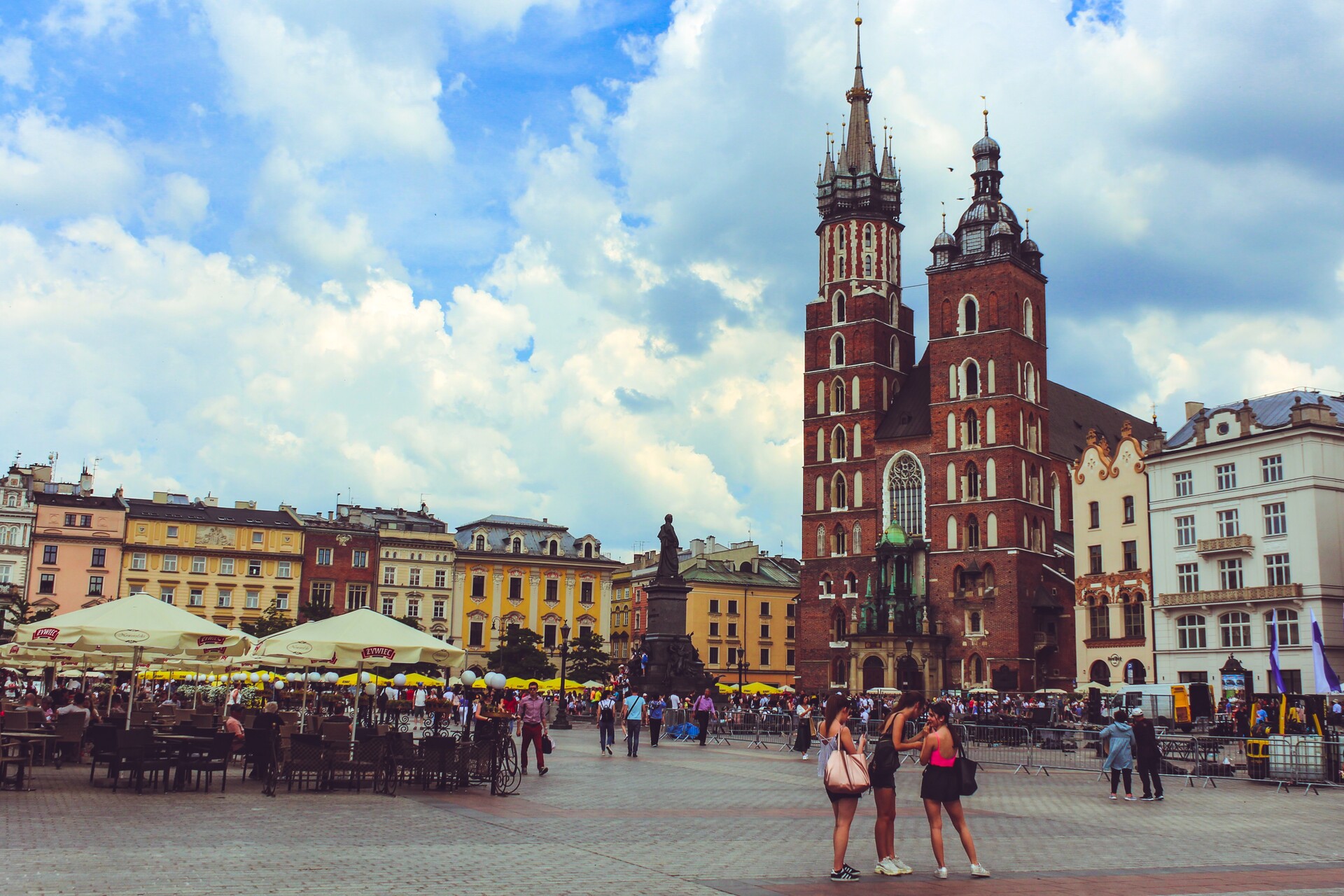
Krakow Market Square, in Polish called “Rynek”, is considered as the centre of the city and a place where everyone meets to have a stroll around the city, have dinner with friends or family or a beer in one of the many restaurants and bars located around the main square.
It was first designed in 1257 and has not changed much since. Measuring 200 square metres, Krakow’s Main Square is one of the largest medieval squares in Europe that hides lots of secrets, legends and is truly magical. One of the biggest attractions that can be found there is Saint Mary’s Church with its stunning altar made by Veit Stoss and a bell chime that can be heard from its towers every hour. There is also the Cloth Hall (Sukiennice), where you can find one of the highest quality ambers from Poland and handmade jewellry, the old Town Hall (Ratusz) that used to be the city's administrative hub and seat of the great council and the underground museum, where one can discover the history of the city, and the monument of Adam Mickiewicz, one of the most famous Polish writers, where high school students gather before their final exams to ask him for help.
Cloth Hall (Sukiennice)

Located in the middle of the Market Square, Sukiennice is one of the most emblematic buildings in Krakow. In the past, it was one of the most important trade places, where merchants from all over Europe would come to discuss the state of business and buy/sell textiles, spices, leather, etc. Sukiennice is also considered one of the first shopping malls in the world.
Nowadays, it is one of the most tourist-oriented spots in Krakow, where you can find dozens of small stalls that sell souvenirs, amber from the north of Poland, handmade jewellery, etc. So do not miss this place if you are looking for something original and unique. On the upper floor of Sukiennice there is a museum, which you can visit for free every Sunday.
Barbican (Barbakan)

The Barbakan is one of the few remaining fortifications of Krakow and a historic gateway that led to the centre of the city. It was built around 1498 and it served as a checkpoint for all who wanted to enter the city. Originally, it was connected with the city walls that protected the city.
Currently, it is a tourist attraction and home to many exhibitions. It opens from Monday to Sunday and if you decide to visit Barbakan, you will have to pay 5 zloty (regular) and 4 zloty (discounted) to enter.
Wawel Castle
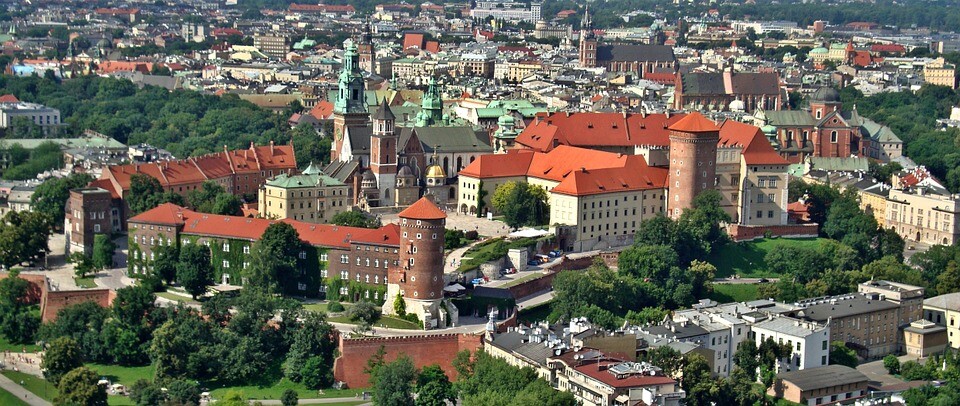
Wawel Castle is one of the most emblematic symbols of Krakow that looks over the city, located by the Vistula river. The Castle and the Cathedral are believed to be built around 1000AD. It was Mieszko I, Poland’s first ruler, who chose Wawel as one of his official residences. Later on, in 1319 the first Polish king, Władysław Łokietek, was crowned in Wawel Cathedral. His coronation started the tradition that would see another 35 royal rulers until the XVII century when the capital of Poland was moved to Warsaw (1596). All of the rulers would use Wawel as a residence, however, during the Austrian occupation and then the Nazi occupation, it was used as a military hospital and the headquarters of the Nazi Governor General, Hans Frank. Fortunately, the castle and its Cathedral remain almost untouched and tourists from all over the world can admire its beauty and mixture of different styles, Medieval, Romanesque, Renaissance, Gothic and Baroque.
The current Cathedral was built in 1364 by order of Władysław Łokietek, the first cathedral, which was made of wood, burnt down. Inside the Cathedral you can find the tomb of the former Bishop of Kraków, St. Stanisław, 18 remarkable chapels, the Royal Crypts, a resting place of kings and statesmen, and the Zygmunt Bell Tower. It is said that it can be heard 50 km away. You can visit the Cathedral for free, unless you are willing to climb the tower and visit the Royal Crypts. Then, you will have to pay 12 zloty for regular ticket (3 euros) and 7 zloty for discounted (around 2 euros).
Nowadays, the castle is a museum that includes five separate sections:
1. Crown Treasury and Armoury - this exhibition is located on the ground floor of the castle and is related to the historic institution of the Crown Treasury and weapons from the late 15th to the early 19th centuries. The opening hours are as follows:
Monday: 9:30 am - 1:00 pm
Tuesday - Friday: 9:30 am - 5:00 pm
Saturday and Sunday: 10:00 am - 5:00 pm
Monday and Sunday - closed
Tuesday - Saturday: 9:30 am - 4:00 pm
A regular ticket during the summer season costs 18 zloty (around 4.50 euros) and discounted 11 zloty (around 3 euros), with free admission on Mondays. And during the winter season, a regular ticket costs 16 zloty (4 euros) and half rate, 9 zloty (2.50 euros).
2. State Rooms - this is the main exhibition of the castle and includes various rooms on the ground floor and guest apartments on the second floor (The Governor’s Parlour, The Tournament Hall, The Envoys’ Room, The Planet Room, The Bird Room, The Royal Chapel, The Eagle Room, The Senator’s Hall). The opening hours are as follows:
Monday closed
Tuesday - Friday: 9:30 am - 5:00 pm
Saturday and Sunday: 10:00 am - 5:00 pm
Monday closed
Tuesday - Saturday: 9:30 am - 4:00 pm
Sunday: 10:00 am - 4:00 pm
A regular ticket during the summer season costs 18 zloty (around 4.50 euros) and discounted 11 zloty (around 3 euros). During the winter season, a regular ticket costs 16 zloty (4 euros) and the half rate costs 9 zloty (2.50 euros) (free admission on Mondays).
3. Royal Private Apartments - this guided tour (available in Polish and English) includes visiting royal bedchambers and guest rooms located on the first floor of the castle that show how the royals lived. The opening hours are as follows:
Monday closed
Tuesday - Friday: 9:30 am - 5:00 pm
Saturday and Sunday 10:00 am - 5:00 pm
Monday and Sunday - closed
Tuesday - Saturday: 9:30 am - 4:00 pm
A regular ticket during the summer season costs 25 zloty (around 6 euros) and a discounted ticket costs 19 zloty (around 2.50 euros) and during the winter season, a regular ticket costs 21 zloty (around 5 euros) and a half rate ticket 16 zloty (4 euros) (guided tour included in the price).
4. Lost Wawel - this exhibition is related to the history of Wawel Hill and includes architectural and archaeological elements from various periods. All the objects that are found during this tour are arranged in thematic groups. The opening hours are as follows:
Monday: 9:30 am - 1:00 pm
Tuesday - Friday: 9:30 am - 5:00 pm
Saturday and Sunday: 10:00 am - 5:00 pm
Monday closed
Tuesday - Saturday: 9:30 am - 4:00 pm
Sunday: 10:00 am - 4:00 pm
A regular ticket during the summer season costs 10 zloty (around 2.50 euros) and the discounted ticket costs 7 zloty (around 1.50 euro) (free admission on Mondays). During the winter season, a regular ticket costs 8 zloty (around 2 euros) and a half rate ticket costs 5 zloty (around 1 euro) (free admission on Sundays).
5. The Exhibition of Oriental Art - this exhibition includes some elements of art from the Near East which used to be very fashionable amongst the Polish nobility, for instance, unique collections of Chinese ceramic and Japanese porcelain. The opening hours are as follows:
Monday closed
Tuesday - Friday: 9:30 am - 5:00 pm
Saturday and Sunday: 10:00 am - 5:00 pm
Monday and Sunday - closed
Tuesday - Saturday: - entrance only at 11:00am and 2:00pm
A regular ticket during the summer season costs 8 zloty (around 2 euros) and the discounted ticket costs 5 zloty (around 1.50 euro) (free admission on Mondays). During the winter season, a regular ticket costs 7 zloty (around 2 euros) and a half rate ticket costs 4 zloty (around 1 euro) (free admission on Sundays).
*There is a daily limit on the number of visitors to each Wawel exhibition.
If you are willing just to admire the castle and its courtyards from the outside, and beautiful views on the city of Krakow, you may do so for free from Monday to Sunday, from April to September from 6.00 a. m. to 8.00 p. m. and from October to March from 6.00 a. m. to 5.00 p. m.
The last attraction that Wawel has to offer and that no one should miss is the visit to the Dragon’s Den (Smocza Jama). The cave was formed about 25 million years ago and it is located beneath Wawel where Smok Wawelski or the Wawel Dragon once lived. The legend says that once upon a time on the bank of the Vistula River, there lived a dragon; the dragon was an evil and nasty creature and he made the whole town afraid. In order to calm him down, the people of Krakow had to put a sheep in front of his cave everyday. One day, King Krak announced that he was looking for a brave knight who would defeat the dragon, which is when Dratewka came to the king. His plan was to fill the sheepskin with salt, pepper and pitch and leave it at the dragon’s cave. When the dragon saw the “sheep” in front of his cave he automatically ate it and shortly afterwards he felt a terrible burning all over his body, so to stop this feeling, he started drinking the Vistula river until he exploded! Dratewka became a hero and married the princess Wanda, and they lived happily ever after.
To visit the cave and see how the dragon who once terrorised the city of Krakow lived, you have to pay 3 zloty (less than 1 euro).
Kazimierz - Jewish district

Kazimierz is a historical district of Krakow, located south of Krakow Old Town and the centre of Jewish life in Kraków for over 500 years. It was called Kazimierz after the king of Poland Kazimierz III Wielki, who declared this district a new town. Once upon a time, Kazimierz played an important role in the economy of Krakow as the Jewish community in Krakow was well-known for its trading activities. Thanks to its rapid growth, the local Jewish community served as a model for other Jewish communities in the Polish kingdom.
However, during WWII, the situation changed drastically. The Jews of Krakow were relocated by the Nazis into a ghetto in the Podgórze district and into Auschwitz-Birkenau. Most of them were later killed during the liquidation of the ghetto or in death camps.
Nowadays, Jewish culture is being re-introduced with the annual Jewish Cultural Festival and many other events that take place in Kazimierz. We can still observe the restoration of many important historic sites in Kazimierz and Jewish culture that includes Jewish-themed bars, restaurants or even bookstores.
Some of the most important synagogues that one should visit are (for more information on Synagogues go to Old Synagogues in Kazimierz):
- Old Synagogue
- Remuh Synagogue
- High Synagogue
- Isaak Synagogue
- Kupa Synagogue
- Tempel Synagogue
Apart from the synagogues, it is also advisable to visit:
Old Jewish Cemetery (Remuh Cemetery) in Krakow - it is an inactive historic Jewish cemetery located beside the Remuh Synagogue, which holds the gravesites of many notable Polish Jews. During the Nazi occupation it was destroyed and many tombstones were used as paving stones in the camps or sold. After the war, they were returned and re-erected.
Market Square Wolnica with a town hall, now housing an ethnographic museum.
Gothic St Catherine's Church - it is one of the most beautiful Gothic churches in Krakow decorated with Gothic murals and 17th century paintings.
Gothic Corpus Christi Church - built in the 14th century, it is one of the biggest churches in Krakow. The legend says that a robber who had stolen a precious relic from another church had a change of mind and abandoned it. The priest who discovered it left on the ground, decided to build a church here in recognition of the miracle.
Baroque Church on the Rock (Skałka) - it is one of the most famous Polish sanctuaries where the Bishop of Krakow Stanisław Szczepanowski was slain by order of the king Boleslaw II Szczodry, who was later exiled. The crypt underneath the church is a burial place for some of the most distinguished Poles.
Municipal Engineering Museum - it is the oldest tramway shed in Krakow established in October 1998. Nowadays, it features different exhibitions including the history of public transport in Krakow and the development of the Polish automotive industry. The museum is open from Tuesday to Sunday and it costs 10 zloty (regular) and 7 zloty (discounted). Permanent exhibition entry is free on Tuesdays.
Ratusz

The tower of Ratusz is the only remaining part of the old Town Hall, which in 1820 was demolished under the Austrian Partition. During the 14th and early 19th century, it was the city's administrative hub and seat of the great council.
It is situated right next to the Cloth Hall (Sukiennice) and today we find a café there and a theatre, where the best Polish actors perform. Definitely worth a visit.
Museums

Sukiennice Gallery
The Sukiennice Gallery is located on the second floor of the building. Due to its location and its exceptional character, Sukiennice became the first seat of the National Museum in Krakow. The museum was first inaugurated on the 11th September 1883. Since then, the permanent gallery of the National Museum was located there.
During WWI and WWII, the museum was closed and then reopened after the war with new exhibitions which presented Polish paintings and sculptures from the Enlightenment to the 19th century. Nowadays, the exhibitions are presented in the following four rooms:
- The Bacciarelli Room: the Enlightenment.
- The Michałowski Room: Romanticism.
- The Siemiradzki Room: Around the Academy.
- The Chełmoński Room: Realism, Polish Impressionism, Beginnings of Symbolism.
For those who would like to visit this museum, it opens from Tuesday to Saturday: 10:00 am - 6:00 pm, and on Sundays: 10:00 am - 4:00 pm.
Ticket prices:
- Regular - 16 zloty (4 euros)
- Discounted - 9 zloty (2.50 euros)
- Students under 26 - 1 zloty (0.25 euro)
- Sunday - free admission to permanent exhibitions.
Audioguide available in Polish, English, Russian, German and French:
- Regular pass - 7 zloty (1.70 euro)
- Reduced pass - 5 zloty (1.25 euro)
Market Square Underground
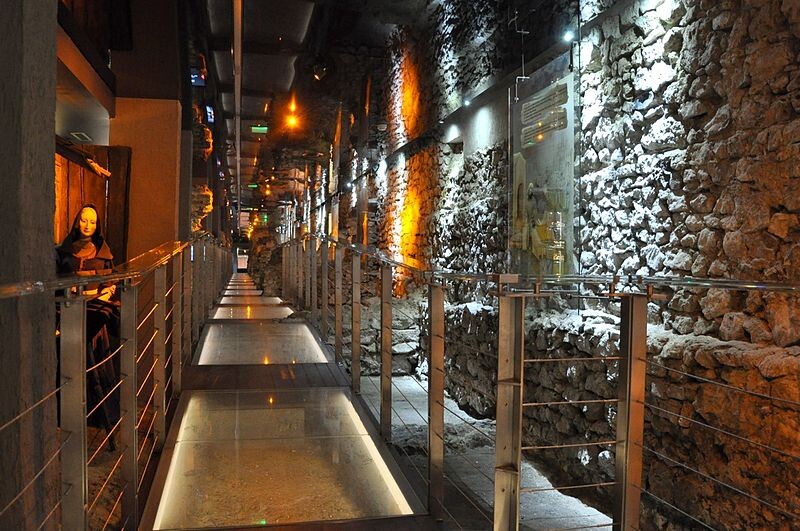
The museum is located just beneath the main market square. Archeological works on the museum started in 2005 and lasted for 5 years, as the layers of the Main Square contain 1000 years of history, therefore everything had to be done with special caution. The Underground Museum presents connections between Middle Age Krakow and other Middle Age European cities. If you want to find answers to all your questions about Middle Age Krakow and know more about this amazing city, you just have to go underground and discover all the routes.
The museum opens from April to October:
And from November to March:
Ticket prices:
- Regular - 19 zloty (5 euro)
- Discounted - 16 zloty (4 euro)
*Admission free on Tuesday. Closed on every second Monday of the month.
The number of tickets is limited, so make sure that you book it at reservation system. The entrance is every 15 minutes and the maximum capacity is 30 people. There is also a guide and audio-guide available in English, German, French, Spanish, Italian, Russian.
National Museum
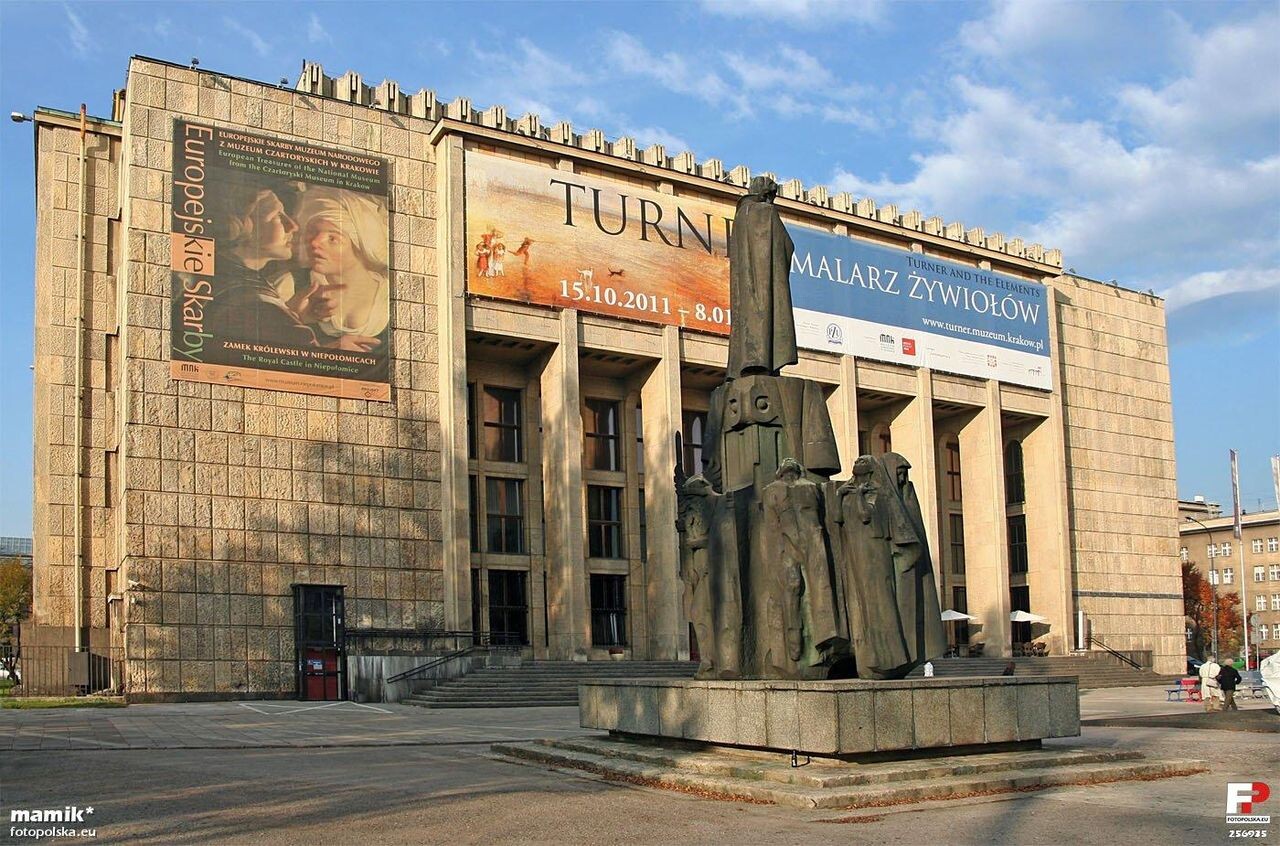
The National Museum is located 10 minutes walking from Krakow Market Square, right next to Jordan Park and Blonia (Aleja 3 Maja 1). The main museum building was designed and constructed between the years 1934 and 1989 by Bolesław Schmidt, Czesław Boratyński and Edward Kreisler, and today, it houses three permanent galleries and some short-term exhibitions:
Some of the most popular exhibitions are the thematic ones, where visitors can admire the works of Marc Chagall, Andy Warhol or Reinholdt Würth. Some of the most popular displays include: Self-portrait of the Poles, Between Mount Giewont and Parnassus or Images of Death in the Polish Art of the 19th and 20th Centuries.
The museum opens from Tuesday to Saturday: 10am - 6pm, and on Sundays: 10am - 4pm.
Ticket prices:
For those who would like to visit the Permanent Galleries only (Gallery of 20th-century Polish Art, Gallery Arms and Uniforms in Poland, Gallery of Decorative Art) the prices are as follows:
- Regular - 11 zloty (3 euros)
- Discounted - 6 zloty (1.50 euro)
- Students under 26 - 1 zloty (0.25 euro)
*Sunday - free admission to permanent exhibitions.
If you are willing to see temporary exhibitions only, then you will have to pay:
- Regular - 12 zloty (3 euros)
- Discounted - 8 zloty (2 euros)
You can also buy a combined ticket that will allow you to visit both permanent and temporary exhibitions. This ticket is valid for 30 days, but you can only use it once:
- Regular - 24 zloty (6 euros)
- Discounted - 16 zloty (4 euros)
Otherwise, the National Museum offers museum passes. With this pass, you will be able to visit all the branches of the National Museum (Sukiennice, the Czapski museum, the Czapski pavilion, the Matejko house, the Szołayski house, the Princes Czartoryski museum, the Princes Czartoryski library, the Szymanowski museum, the Mehoffer house, the Erazm Ciołek palace and the europeum):
- Regular pass - 35 zloty (9 euros)
- Reduced pass - 28 zloty (7 euros)
There is an audio guide available in Polish, English, Russian, German and French:
- Regular pass - 7 zloty (2 euros)
- Reduced pass - 5 zloty (1.50 euro)
Manggha Museum of Japanese Art and Technology
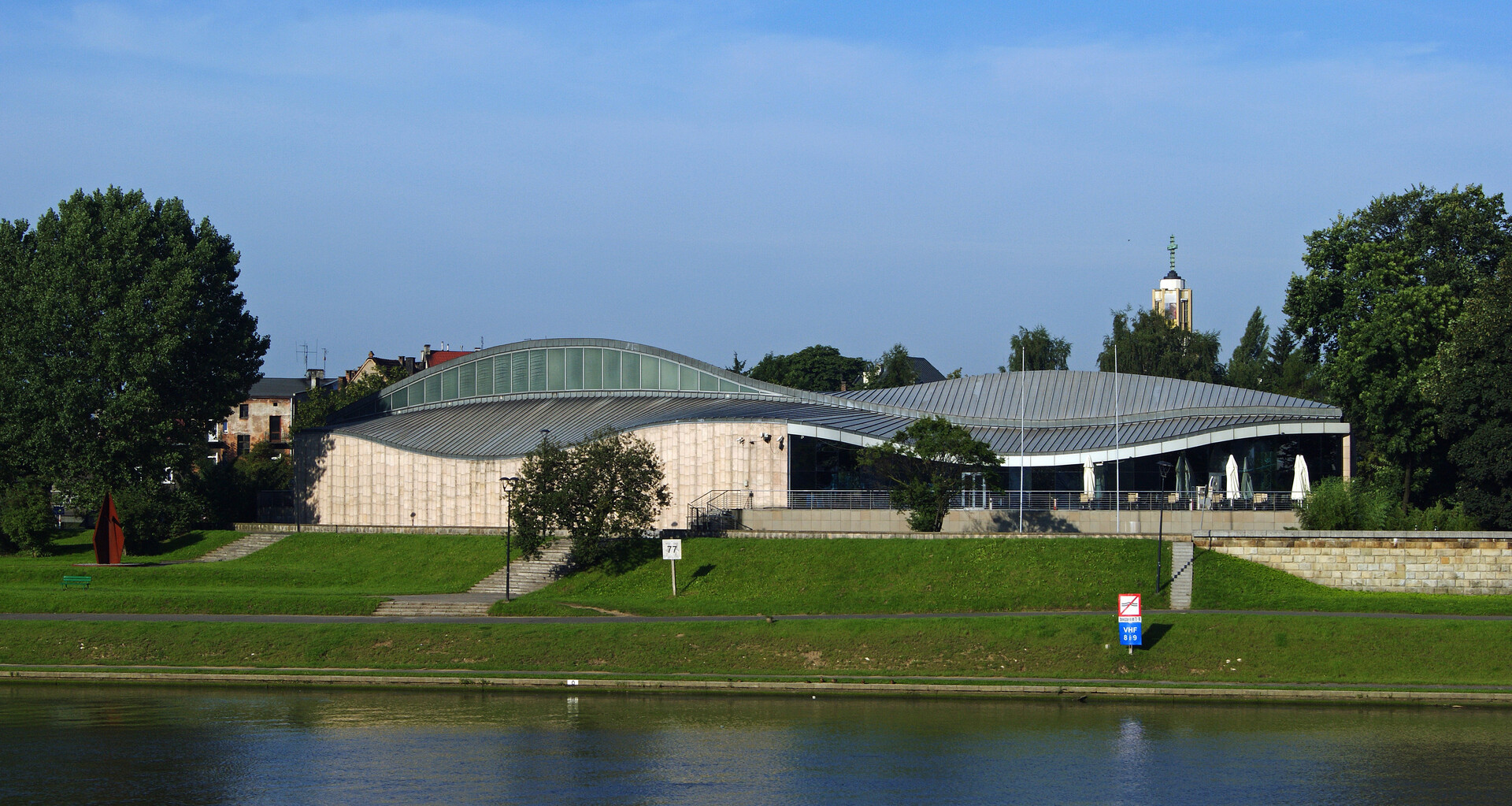
This unique and completely different museum situated on the bank of river Vistula (ul. Marii Konopnickiej 26), is a must-see for all those interested in Japanese culture or for those who would simply like to see and learn something new. It was created on the initiative of Andrzej Wajda (Polish film and theatre director) and opened in 1994 as the Manggha Centre of Japanese Art and Technology. The building was designed by Arata Isozaki, a Japanese architect.
The Manggha Museum is both a museum and an active cultural centre, where one can learn about Japan and the Far East. The museum’s main focus is on the visual arts, but also on the music, theatre, film, literature, philosophy and religion of those regions. Apart from permanent and temporary exhibitions, it offers different events and activities often relating to traditional Japanese festivals, the tea ceremony, bonsai, suiseki, or ikebana.
The museum opens from Tuesday to Sunday: 10am - 6pm.
Ticket prices:
- Regular - 20 zloty (5 euros)
- Discounted - 15 zloty (4 euros)
*Tuesday - free admission.
Jagiellonian University Museum - Collegium Maius
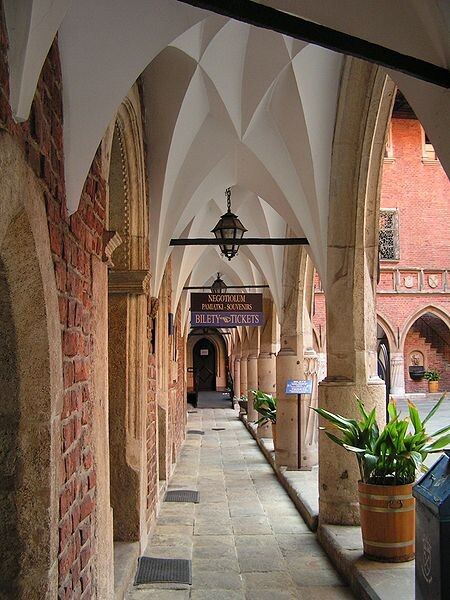
The Jagiellonian University Museum is situated in the oldest university building in Poland - Collegium Maius, right next to Krakow’s main square (ul. Jagiellońska 15). Its collection combines a rich collection of scientific instruments, including the first globe showing America, and the art collection with paintings by Polish artists (Jan Matejko, Olga Boznańska, Józef Mehoffer, among others). One of the most visited exhibitions is “The World of the Senses”, where the visitors can discover the anatomical or physical bases of the function of the sensory organs by using interactive models.
The museum opens:
Monday, Wednesday, Friday: 10:00 am - 2:20 pm (last admission)
Tuesday, Thursday: 10:00 am - 2:20 pm (last admission); from April to October, last admission at 5:20 pm
Saturday: 10:00 am - 2:20 pm (last admission)
Ticket prices:
Interactive exhibition:
You can visit the museum for free from 19th November to 31st March 2016 on Saturdays from 10 am to 2 pm.
Oskar Schindler’s Factory
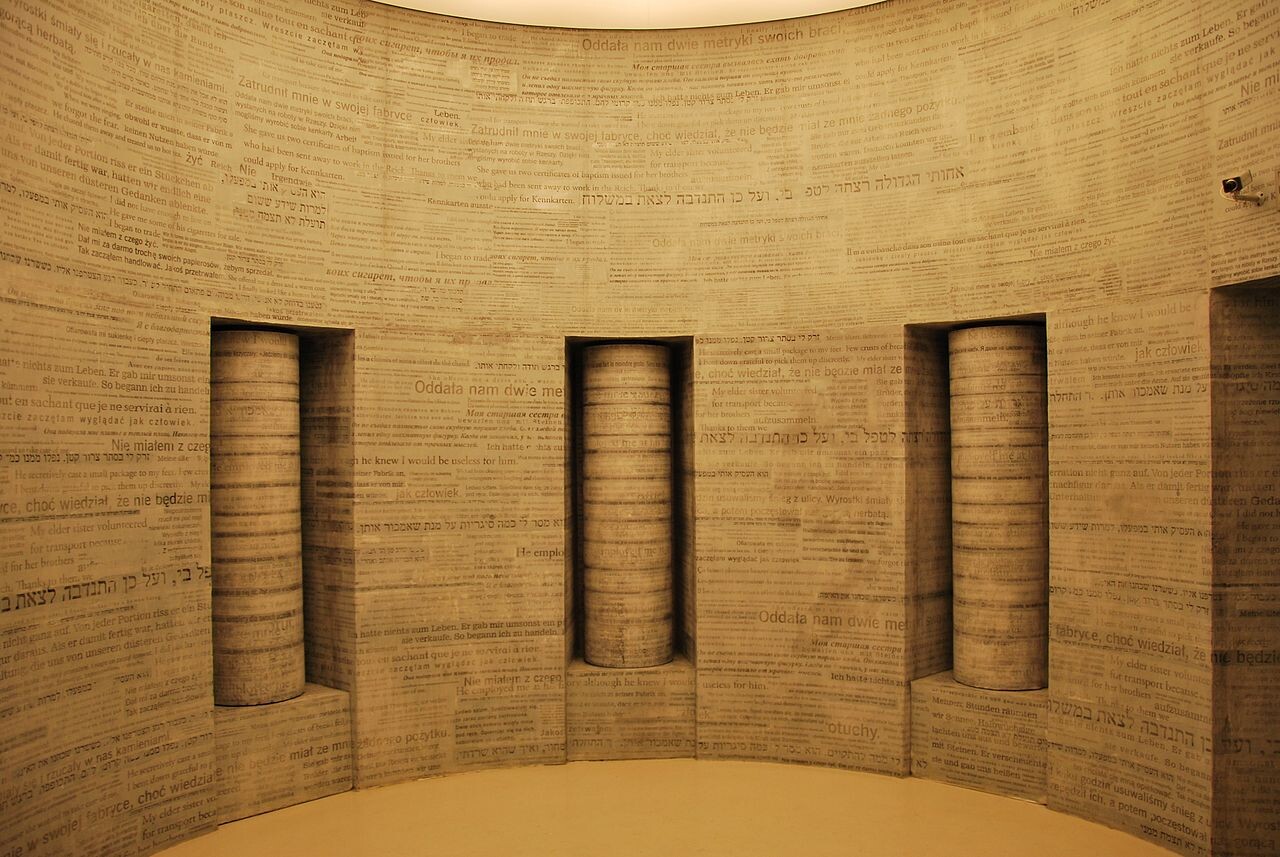
The museum is located in the post-industrial district of Krakow-Zablocie in the building known as Oskar Schindler’s Deutsche Emailwarenfabrik (ul. Lipowa 4). The permanent exhibition "Kraków under Nazi Occupation 1939-1945" shows the story of Krakow and its inhabitants’ lives, as well as the city’s underground resistance during World War II. The museum exhibits different multimedia installations, archival documents, photos, radio and film recordings from that period. Apart from that, two rooms are dedicated to the story of Oskar Schindler and the Jews’ whose lives he managed to save.
If you are planning on visiting the museum, you should prepare to spend at least an hour or two there. Make sure that you come at least 1.5 hours before closing (last admission). It is also advised to book your ticket in advance. The opening hours are as follows:
Monday: 10:00 am - 2:00 pm
Tuesday - Sunday: 10:00 am - 6:00 pm
Monday: 10:00 am - 4:00 pm
Every first Monday of the month - until 2:00 pm
Tuesday - Sunday: 9:00 am - 8:00 pm
Ticket prices:
- Regular: 21 zloty (5 euros)
- Discounted: 16 zloty (4 euros)
Admission to the permanent exhibition is free on Mondays. The number of tickets is limited.
Churches and Synagogues
Saint Mary’s Basilica

The reconstruction of the Basilica started in the 13th century after it had been destroyed by Tartar raids. The new basilica situated in the main market square was consecrated around the year 1320, the towers were added in the 15th century. There is a legend related to the towers. As you will notice, one is way taller than the other. According to the legend, they were built by two brothers, however, when the younger one realised that his older brother was going faster, he grew jealous and decided to kill him with a knife. As he felt guilty, he committed suicide by jumping from the top of one of the towers. The knife still hangs today at the gate of Sukiennice.
The most remarkable element of the Basilica is the Gothic style wooden altar sculpted by Veit Stoss between the years 1477-1489. It includes more than 200 carved and painted figures and the panels present medieval life in detail. What’s more, the amazing stained glassed windows were created by one of the most famous Polish artists Stanisław Wyspiański and Józef Mehoffer.
Every hour from the tallest tower of the Basilica, you can hear a “Hejnal Mariacki” played by the trumpeter. The music breaks off on an abrupt half-note to remember a bugler who was killed by a Tartar arrow during Tartar raids. Back in those days, the bugler would play from the tower to warn the city of the invaders.
You can visit the Basilica from Monday to Sunday from 11:30 am - 6:00 pm. Regular ticket costs 10 zloty (2.50 euros) and discounted 5 zloty (1.50 euro).
If you want to climb one of the towers and admire the views, you just have to check opening hours. The tower might close in case of bad weather conditions:
From April to October:
Tuesdays to Saturdays: 9:10 am - 5:30 pm (every 30 minutes). There is a break between 11:30 am and 1:10 pm
Sundays 1:10 pm - 5:30 pm (every 30 minutes)
In November, December and March:
Thursday, Friday and Saturday: 9:10 am - 5:40 pm (every 30 minutes). There is a break between 11:30 am and 1:10 pm
January and February: closed
Ticket prices:
- Adult - 15 zloty
Church of St. Peter and St. Paul
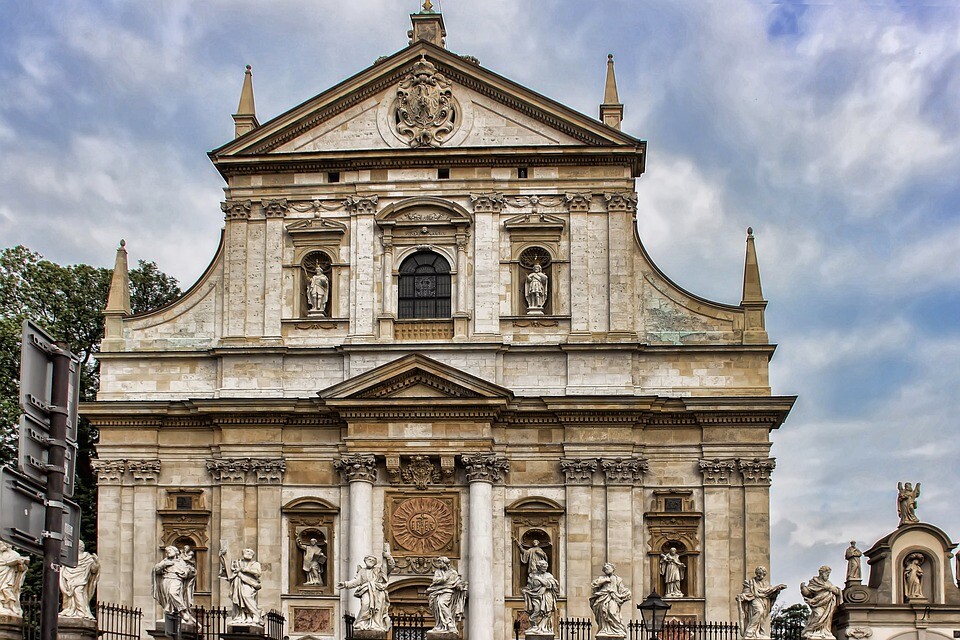
It is a Baroque Jesuit church located 5 minutes away from the Market Square. It’s mostly famous for its 12 statues of the Apostles lining the fence at the front. It is said that the Jesuits spent so much money on the statues and the facade that they did not have enough to finish the church itself. The interior of the church is decorated with scenes of the life and death of Saints Peter and Paul.
Dominican Church and monastery
The Dominican Church and monastery situated right between the Saint Mary’s Basilica and the Church of St. Peter and St. Paul, is a great example of Gothic architecture. Unfortunately, during the fire in July 1850 that also destroyed some parts of the historic centre of Krakow, the church suffered irreparable losses.
One of the most emblematic elements of the church is the chapel of St Hyacinth approached by a flight of marble steps and the sanctuary of Our Lady of the Rosary with the miraculous picture of Our Lady of the Rosary. Furthermore, one of three cloisters of the vast Dominican monastery can be found in the Dominican Church. Its hallways exhibit historic paintings showing miracles that involved the Black Friars and scenes from the history of the Dominican Order.
Franciscan Church - The Basilica of St. Francis of Assisi

It is one of the oldest churches in Krakow and also, one of the most famous. It is located right next to the Market Square and in front of the Bishop’s Palace, where Karol Wojtyla, later known as Pope John Paul II, once lived.
The church was built in the 13th century, however, we can only assume who the founder was. Some say it was Boleslaw V the Chaste, but that’s rather doubtful. In 1920, Pope Benedict XV elevated the church to the rank of basilica minor.
Old Synagogues in Kazimierz
Old Synagogue - it is the oldest synagogue in Poland built in 1407 or 1492. It was completely devastated by the Nazis during World War II and nowadays operates as a museum. Various permanent and temporary exhibitions are dedicated to the synagogue and the most important Jewish holidays, as well as to the family and private life.
Ticket prices:
Audio guide available in Polish, Hebrew, English, German - 10 zloty (2.50 euros)
Winter season (November - March)
Monday: 10:00 am - 2:00 pm
Tuesday - Thursday, Saturday - Sunday: 9:00 am - 4:00 pm
Friday: 10:00 am - 5:00 pm
Summer season (April - October)
Monday: 10:00 am - 2:00 pm
Tuesday - Sunday: 9:00 am - 5:00 pm
*Free admission on Monday
Remuh Synagogue - this synagogue is the smallest of all synagogues in Kazimierz but also the most active one. The synagogue was founded by the family of famous 16th century Polish rabbi Moses Isserles, also known as the Rema. Next to the synagogue there is the Old Jewish Cemetery, where many noble Polish Jews lay.
The synagogue opens from Monday to Friday and on Sundays: 9:00 am - 5:00 pm (sometimes until 6:00 pm).
Ticket prices:
- Regular - 10 zloty (2.50 euros)
- Discounted - 5 zloty (1.50 euro)
High Synagogue - it used to be the tallest synagogue in the city, however, during the Nazi occupation its ceiling and roof were completely destroyed. Today, no furnishings remain. In 2005 it was opened to visitors and the upstairs prayer room that has retained some original details can be visited.
It opens from Monday to Sunday: 10:00 am - 6:00 pm.
Ticket prices:
- Regular - 9 zloty (2.50 euros)
- Discounted - 6 zloty (1.50 euro)
Isaak Synagogue - this synagogue was named for its donor, Izaak Jakubowicz who was a banker to King Władysław IV and is one of the most beautiful synagogues in Krakow. It was damaged during the Nazi occupation, however, today, it is a practicing Orthodox Synagogue again. The synagogue houses an exhibition that describes the history of Polish Jews with historic photographs and documentary films.
Opening hours:
Monday - Thursday, Sunday: 8:20 am - 8:00 pm
Friday: 8:30 am - 2:30 pm
Saturday: closed
Ticket prices:
- Regular - 7 zloty (1.50 euro)
- Discounted - 4 zloty (1 euro)
Kupa Synagogue - this synagogue is a place where Krakow's Jewish community celebrates various religious ceremonies and cultural festivals, especially, the annual Jewish Culture Festival. The synagogue used to share a wall with the original Kazimierz city defensive walls, which remainings can be seen from ul. Miodowa.
Opening hours:
Monday - Thursday, Sunday: 10:00 am - 4:00 pm
Friday: 10:00 am - 6:00 pm
Saturday: closed
Ticket prices:
- Regular - 5 zloty (1.50 euro)
- Discounted - 3 zloty (0.80 euro)
Tempel Synagogue - still active today, the Temple Synagogue hosts numerous concerts and meetings and is a major place of worship for the Jewish community in Krakow. It is the newest synagogue in Krakow, it dates back to 1862. Fortunately, it survived the Nazi occupation and regular services were held here until 1968.
It opens from Monday to Friday and on Sundays: 10:00 am - 6:00 pm.
Ticket prices:
Where to relax
Krakow Zoo
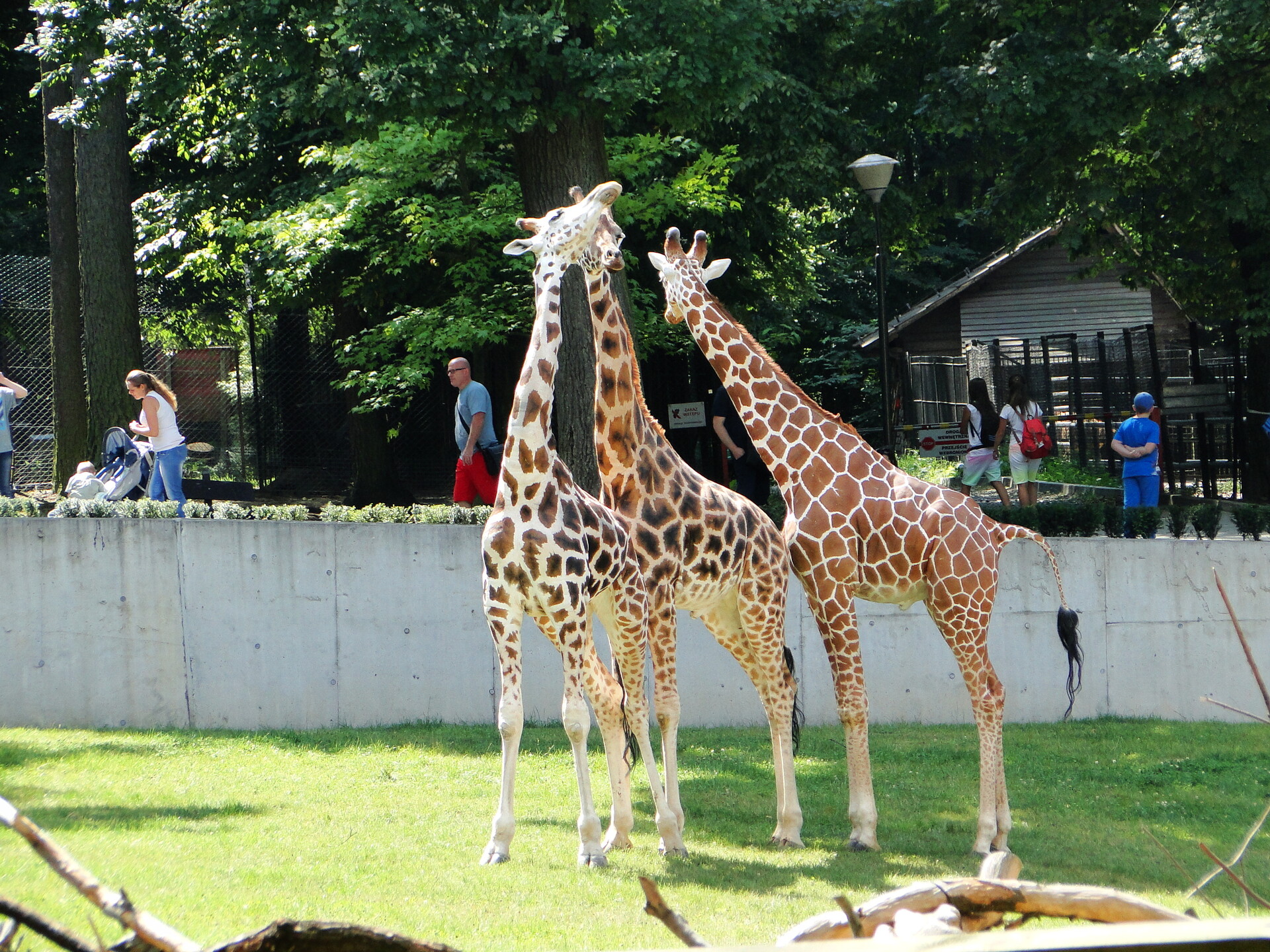
The zoo was first opened in 1929 and today we can find nearly 1500 animals of almost 300 species exhibited there. Among all these different and exotic species you will be able to see Indian elephants, pygmy hippopotami, South American sea lions, Humboldt penguins, giraffes, camels, pheasants, etc. The zoo is surrounded by the Wolski Forest, therefore, it is a perfect place to relax and enjoy the nature. From the zoo, you can also take a walk to one of the mounds that can be found nearby.
As almost everywhere in Krakow, you can take a nice long walk to the zoo, but let’s be honest, you will end up really tired. So alternatively, from the centre you can take the bus number 152 or 192, get off at “Strzelnica”, and then change for the bus number 134, which will take you straight to the zoo.
Ticket prices
You can buy your tickets from Monday to Sunday and on holidays from 9:00 am - 6:00 pm:
- Regular - 18 zloty
- Discounted - 10 zloty
For more information, please visit their official website: ZOO Krakow.
Zakrzówek

This reservoir was accidentally created when the limestone quarry operating there pierced the water table. Even though it’s officially prohibited, during summer days it is one of the most frequented places, where locals come to take a swim, have a picnic, practice scuba diving or rock climbing. The depth varies from 7 - 21m and they say that the bottom hides several rather odd things, such as vehicles, boats or even former changing rooms of the quarry workers. So be careful if you go there, as it is the site of frequent accidents.
The easiest way to get to Zakrzowek from the centre is by tram: number 52. It will take around 30 minutes and you should get off at the tram stop “Norymberska” or “Grota Roweckiego”.
Kryspinów
Probably the most popular summer spot among all the inhabitants of Krakow. This artificial lagoon located some 12 km outside the city is definitely a number one place during hot summer days. The lake comprises a total area of 64 hectares and includes a beach and recreation area. Kryspinów offers tons of attractions and opportunities for adrenaline-pumping watersports, various events and activities organised throughout the season, and if you get hungry and unfortunately forgot to bring something to eat, there is a restaurant there.
In order to get to Kryspinow, you will have to take a tram and then a bus. From the centre you need to take one of these trams: number 1 or 2, towards Salwator. At the “Salwator” stop you will have to change for one of these buses: number 229, 239, 269, and get off at “Kryspinow”.
Make sure that you buy an “Agglomeration I+II” ticket, as you are going outside the city. It should take you around 45 minutes to get there from the centre.
Ticket prices
Access to the recreation area is paid from 8:00 am - 10:00 pm, but discounted after 5:00 pm:
Bagry
Bagry is another lagoon located in the Plaszow district, some 5 km away from the city centre. It is one of the most popular artificial lakes in the city of Krakow, where many locals go on a sunny day to go swimming, sunbathe, sail or rent a kayak. Bagry features three wild beaches and a guarded bathing area. So if you happen to be in Krakow during summer, give it a try!
In order to get to Bagry, you can take any tram from the centre towards “Kurdwanow” or “Nowy Biezanow” (number 3, 13, 50), get off at “Powstancow Wielkopolskich”, and from there either take a bus number 127 or just walk some 15 minutes. Otherwise, you can call a taxi that will take you straight to Bagry.
A walk around Planty

Known as the 'lungs of the city', Planty is a park encircling the centre of the city. Back in the 13th century, there were defensive fortifications there, however, during the Austrian occupation, they were demolished and replaced with this marvellous park. If you want to take a stroll around the city centre through Planty, be prepared to spend almost an hour there, as you will have to walk some 3 km. It is a very popular place amongst musicians, local people, tourists, who just want to enjoy this park filled with trees, flowers, benches and historic monuments. I am sure that you will not miss it, as you will always have to pass through Planty on your way to the centre.
A walk around Błonia

If you enjoy going for a stroll, a bike ride or roller skating, you should definitely go to Blonia. It is an enormous, triangular green open space measuring nearly 50 hectares. It used to be a cow pasture, however, nowadays it is considered a park, even though there are no trees or other defining characteristics. On a sunny day, people bring their blankets and organise picnics, play football, frisbee or other sports. It is located not far from the centre, and you will definitely not miss it, just ask anyone for Blonia and anyone will be able to show you the way.
Kościuszko Mound (Kopiec Kościuszki)

The Kosciuszko Mound was built to commemorate Tadeusz Kosciuszko. The resolution was approved on 19th of July 1820. Kosciuszko was a military leader who later became a national hero in Poland, Lithuania, Belarus, and the United States, where he fought during the American Revolutionary War.
The Kosciuszko mound offers one of the best views on the city of Krakow, with some of the most remarkable monuments, such as Wawel Castle, Mariacki Church or the Cloth Hall, and its surroundings.
In order to get to the mound, you can either walk or take a bus. It is advisable to walk to the mound, as you will be able to admire beautiful views along the way. From the centre of Krakow through Blonia, it should take you around 45 minutes up to one hour to get there. It is a long walk, but it is definitely worth it.
However, if you decide to take a bus for whatever reason you may have, you should look for number 100 or 101 that leave from “Rondo Grunwaldzkie”, just opposite the castle. They depart every hour, so make sure that you check the timetables before you leave. You should get off at the bus stop “Kopiec Kosciuszki”.
Opening hours
Throughout the year, you can visit the Mound from 9:00 am until sunset, and from the 1st May to the 31st September and during holidays, until 11:00 pm.
Ticket prices
A ticket to the Kosciuszko Mound includes:
- The Chapel of the Blessed Bronisława and the Columbarium,
- Kosciuszko Collection,
- Krakow's Mounds,
- The Fortress and the City of Krakow 1846 - 1918,
- Wax Figures "Polish Road to Freedom".
Regular ticket costs 12 zloty (3 euros) and discounted 10 zloty (2.50 euros).
You can also visit the Mound for free on the 4th of February, 24th of March and 15th of October.
Piłsudski Mound (Kopiec Piłsudskiego)
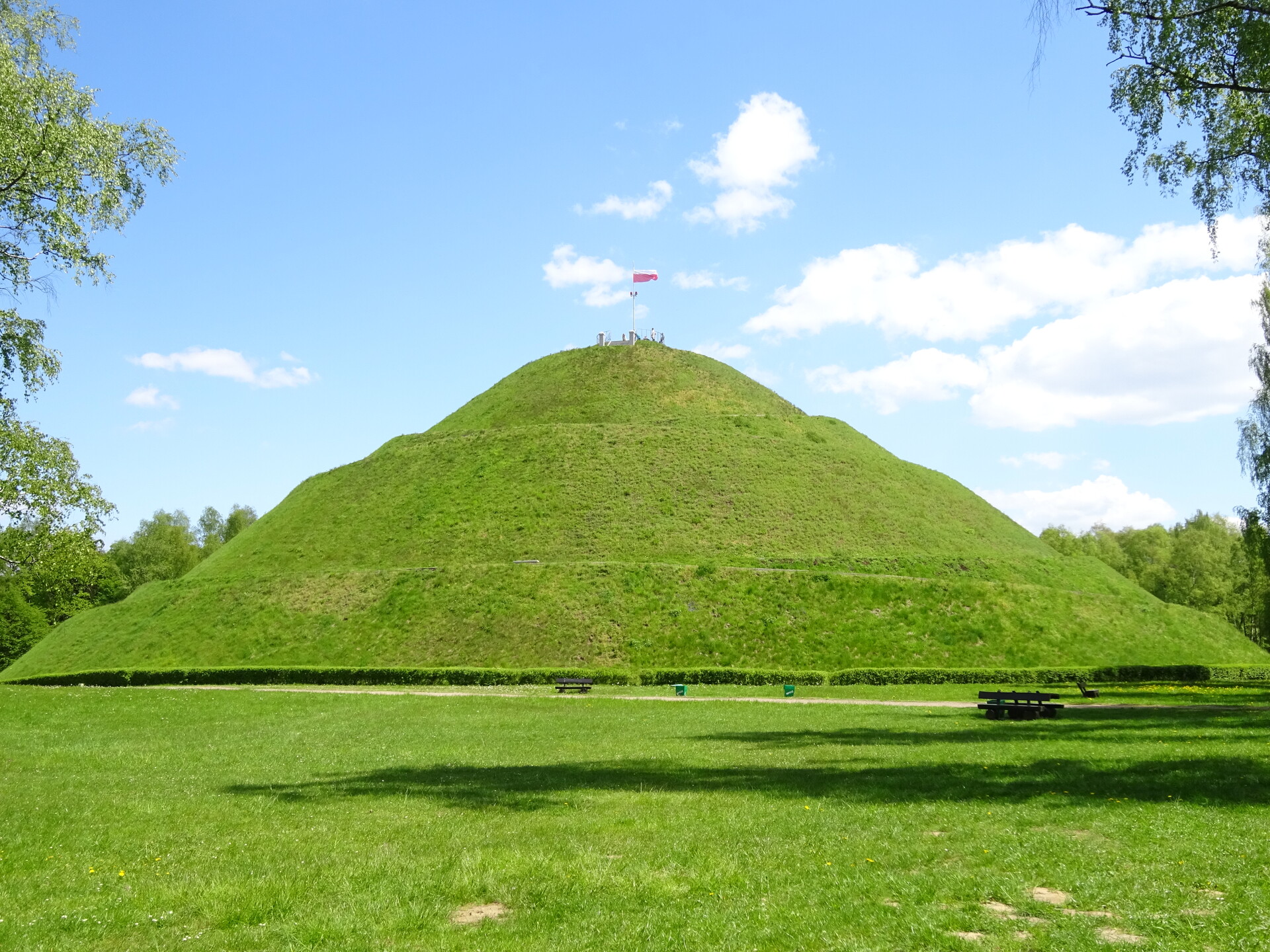
This mound, located around 25 minutes walking from the zoo, was built to commemorate Jozef Pilsudski, Chief of State and leader of the Second Polish Republic. The mound was completed in 1937, just two years after Pilsudski’s death and despite the fact that during the Nazi occupation it was slated for demolition, it stands still until today. From the mound you can admire the beauty of Krakow, its surroundings and on a sunny day even the Tatra Mountains. It is also an excellent place for a picnic. It is free of charge and you can visit it whenever you want.
If you are planning on visiting the Pilsudski Mound, be prepared for a long trip. If you want to walk from the centre to the mound, you should have around 2 hours available or even a bit more if you like enjoying the views and taking lots of pictures. Make sure that you have good walking shoes and a bottle of water with you.
You can also walk to the mound from the zoo, through the Wolski Forest, and enjoy stunning views and the fresh air. It shouldn’t take you more than 30 minutes to get from the zoo to the mound.
If you prefer taking a bus, you should look for one of these numbers: 152, 192 or 252. All of them stop near Blonia, so around 10-15 minutes walking from the Rynek. It takes around half an hour to get from Blonia to the mound, don’t forget to get off at the bus stop called “Chelm”. You will then have to walk for about 20 more minutes.
Krak Mound (Kopiec Kraka)

This mysterious mound located not far from the centre of Krakow, is believed to have been built between the 8th and 10th century, however, some claim that it is of Celtic origin and dates back to the 2nd or even 1st century BC. It was supposedly constructed to honour the death of King Krak. It is 271 metres tall and is the oldest man-made structure in Krakow.
It takes around 50 minutes to walk from the centre of Krakow to the mound. However, you can also take a tram from the centre to the mound. It will take you around 15 minutes and you should get off at “Powstancow Wielkopolskich”.
Wanda Mound (Kopiec Wandy)
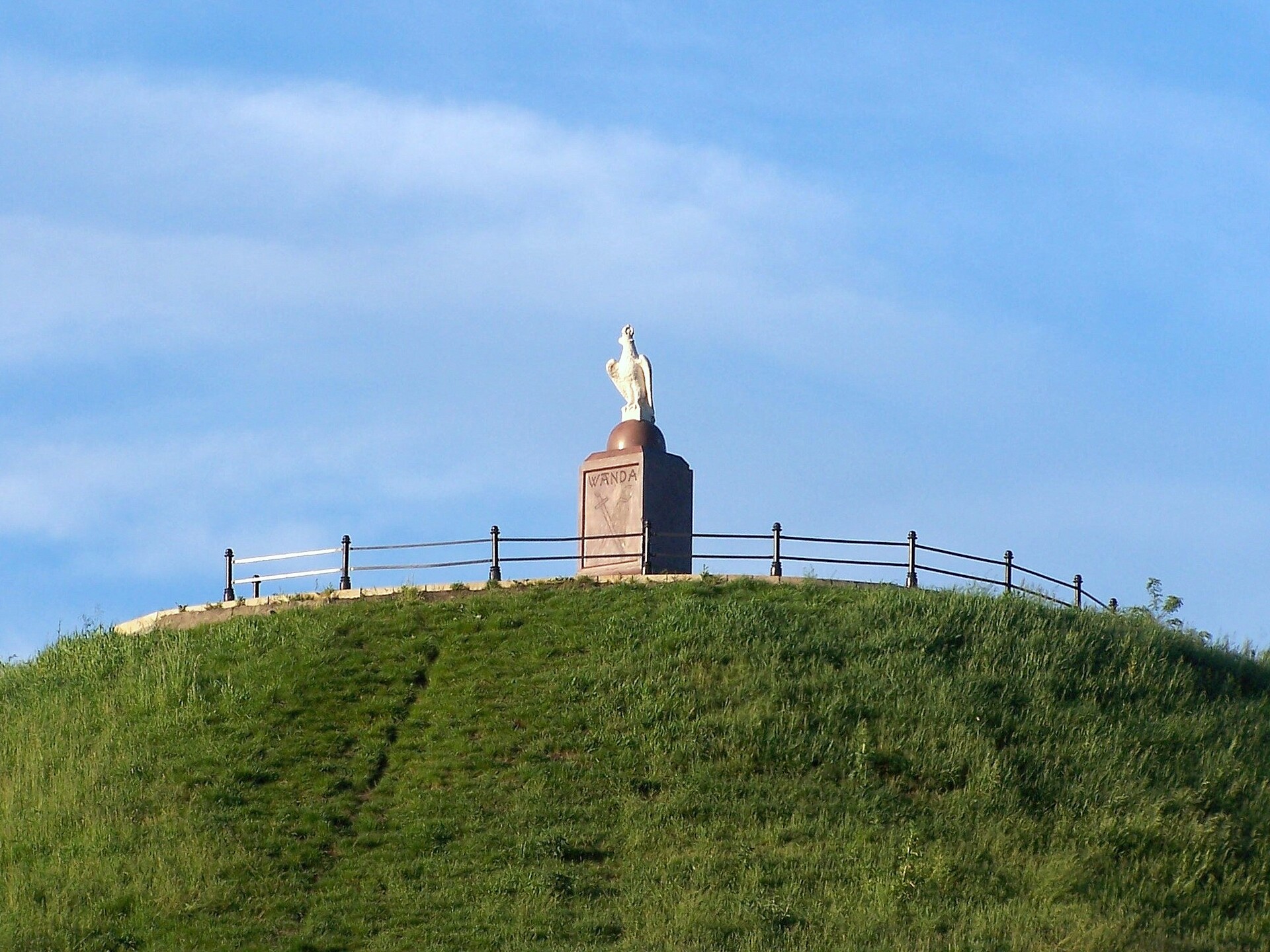
This mound is located in the district Nowa Huta and is the smallest one, as it is only 14 m high. It remains a mystery when and why the mound was built. Some say that under the mound, lays the body of princess Wanda. She was a daughter of the legendary king of Krakow, Krak. According to the legend, since she did not want to marry a German boy, she decided to throw herself into the waters of the Vistula river. The mound is located close to the spot on the river bank where her body was found.
From the city centre (tram stop “Starowislna” you can take the tram number 12 that will take you to the mound in 30 minutes. Get off at the tram stop “Kopiec Wandy”.
Jordan Park (Park Jordański)
The Jordan Park is located right next to Blonia and it was established in 1889 as the first public playground in Krakow. It was professor Henryk Jordan’s idea to create a place where all the kids could exercise both mind and body. During summer you can use one of the sport fields or simply go for a walk, and during winter you can sledge down the snowy slopes. The park is open from 6:00 am till 10:00 pm from Monday to Sunday.
Tyniec
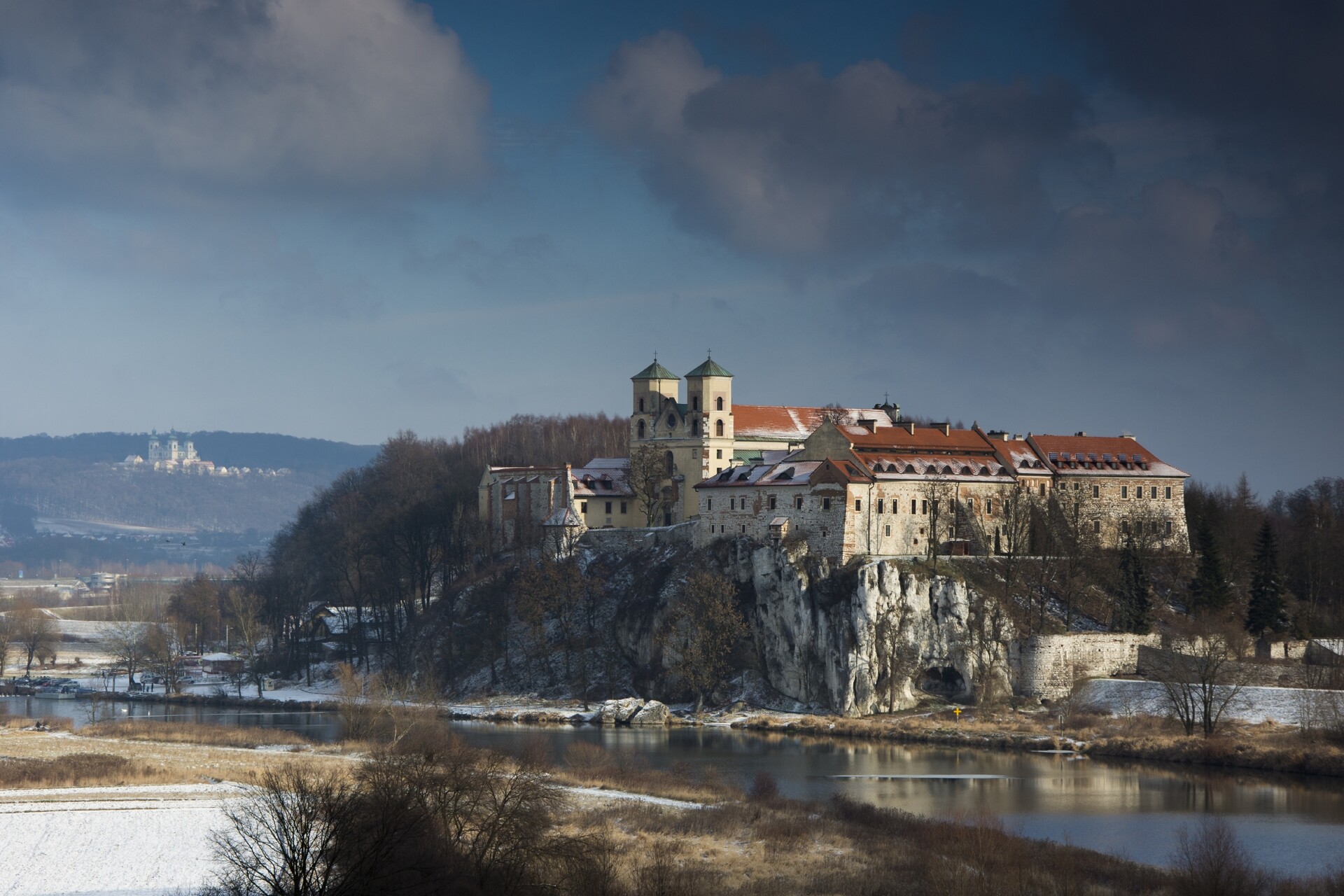
Tyniec, which once used to be a historic village, nowadays is part of the city of Krakow and is famous for its Benedictine abbey founded probably around 1044. The abbey is located 12 km southwest of the center of Kraków, on the right bank of the Vistula river and is situated high on a limestone hill. Thanks to its location, it played the role of a fortress defending access to Krakow.
The road into the Abbey leads through the so-called castle, a 16th-century building of the abbot’s quarters. The complex includes a library that nowadays houses the Benedictine Institute of Culture, and the church of St Peter and St Paul, a three-aisled basilica with baroque furnishing.
What’s more, don’t forget to stop at their restaurant, bookstore and souvenir store if you want to try some traditional food or Benedictine monks’ products (you should try “Pijany mnich”), including their home-made liqueurs.
The easiest way to get to Tyniec is by bus. From “Rondo Grunwaldzkie” (just opposite the Wawel castle, next to the Manggha museum), you have to take the bus number 112 and get off at “Tyniec”. The bus ride should take around 20 minutes.
Weather permitting, you can also go on a nice, long bike-ride. What’s interesting, this 14 km route is part of a network of 15 long distance cycle routes connecting and uniting the whole European continent. Therefore, apart from doing exercise, you will be able to admire beautiful and stunning views and discover those hidden parts of Krakow.
There are also cruises organised from Krakow to Tyniec. So if all you want is to just sit back and relax, this trip is for you. During the cruise you will see the Wawel Castle, Debnicki Bridge, Kosciuszko Mound, Camaldolese Abbey, and much more.
The cruisers leave from the Vistula river bank, right in front of the Wawel castle. It takes 3 hours to go and come back:
From Monday to Saturday: 3:00 pm with a 30 min stop in Tyniec (“Orka” ship).
Sundays and holidays: 4:00 pm with a 1 hour stop in Tyniec (“Nimfa” ship).
Don’t forget to book your cruise in advance!
Ticket prices
- Regular - 60 zloty (15 euros)
- Discounted (children and youth up to 12 years of age) - 50 zloty (12.50 euros)
For more information, please visit: Statek Krakow (available in Polish and English).
Opening hours
If you want to visit the museum and admire the exhibitions (permanent and temporary), you should check these timetables:
From May to October: from 10:00 am - 6:00 pm
From November to April: from 10:00 am - 4:00 pm
And if you want to visit the abbey with the guide:
From May to October
Monday - Friday: 9:00 am - 12:00 pm, 2:00 pm - 5:00 pm
Saturday: 9:00 am - 12:00 pm, 2:00 pm - 4:00 pm
Sunday: 10:15 am, 12:00 pm - 5:00 pm
From November to March
Monday to Saturday: from 9:00 am - 12:00 pm, 2:00 pm - 3:00 pm
Sunday: 10:15 am, 12:00 pm - 3:00 pm
April
Monday to Saturday: 9:00 am - 12:00 pm, 2:00 pm - 4:00 pm
Sunday: 10:15 am, 12:00 pm - 4:00 pm
Ticket prices
If you wish to visit only the museum, you will have to pay:
- Regular - 7 zloty (2 euros)
- Discounted - 5 zloty (1.50 euro)
- The entrance fee with the guide to visit the abbey costs 6 zloty (1.50 euro).
And for those who would like to visit the museum and the abbey, combined tickets are available:
- Regular combined ticket - 10 zloty (2.50 euros)
- Discounted combined ticket - 8 zloty (2 euros)
You can also rent an audioguide - 5 zloty (1.50 euro).
Aquapark (Park Wodny)
This incredible indoor pool complex, which includes 800 metres of water slides, located not far from the city centre and right next to the cinema complex “Multikino”, is a great solution for those who would like to relax, use a sauna or have some fun. The aquapark offers different massage fountains, climbing walls, swings, in-water activities, and much more. Be aware, that on the weekends the place is absolutely full.
In order to get to the aquapark, you can take one of these buses: 129, 132, 152, 182 and 482. It takes around 15 up to 20 minutes to get to the aquapark, and you should get off at “Park Wodny”.
Ticket prices
- From Monday to Friday, weekends and holidays:
- Regular - 27 zloty (7 euros)
- Discounted - 24 zloty (6 euros)
- From Monday to Friday:
- Regular - 15 zloty (4 euros)
- Discounted - 15 zloty (4 euros)
- Regular - 17 zloty (4.50 euros)
- Discounted - 17 zloty (4.50 euros)
- From Monday to Sunday: 35 zloty (8.50 euros)
- From Monday to Friday, weekends and holidays:
- Regular - 38 zloty (9.50 euros)
- Discounted - 34 zloty (8.50 euros)
- From Monday to Friday, weekends and holidays:
- Regular - 43 zloty (11 euros)
- Discounted - 39 zloty (10 euros)
- From Monday to Friday, weekends and holidays:
- Regular - 60 zloty (15 euros)
- Discounted - 47 zloty (12 euros)
- From Monday to Friday, weekends and holidays:
- Regular - 68 zloty (17 euros)
- Discounted - 55 zloty (14 euros)
Opening hours:
The aqua park is open every day from 8:00 am until 10:00 pm.
Cinemas
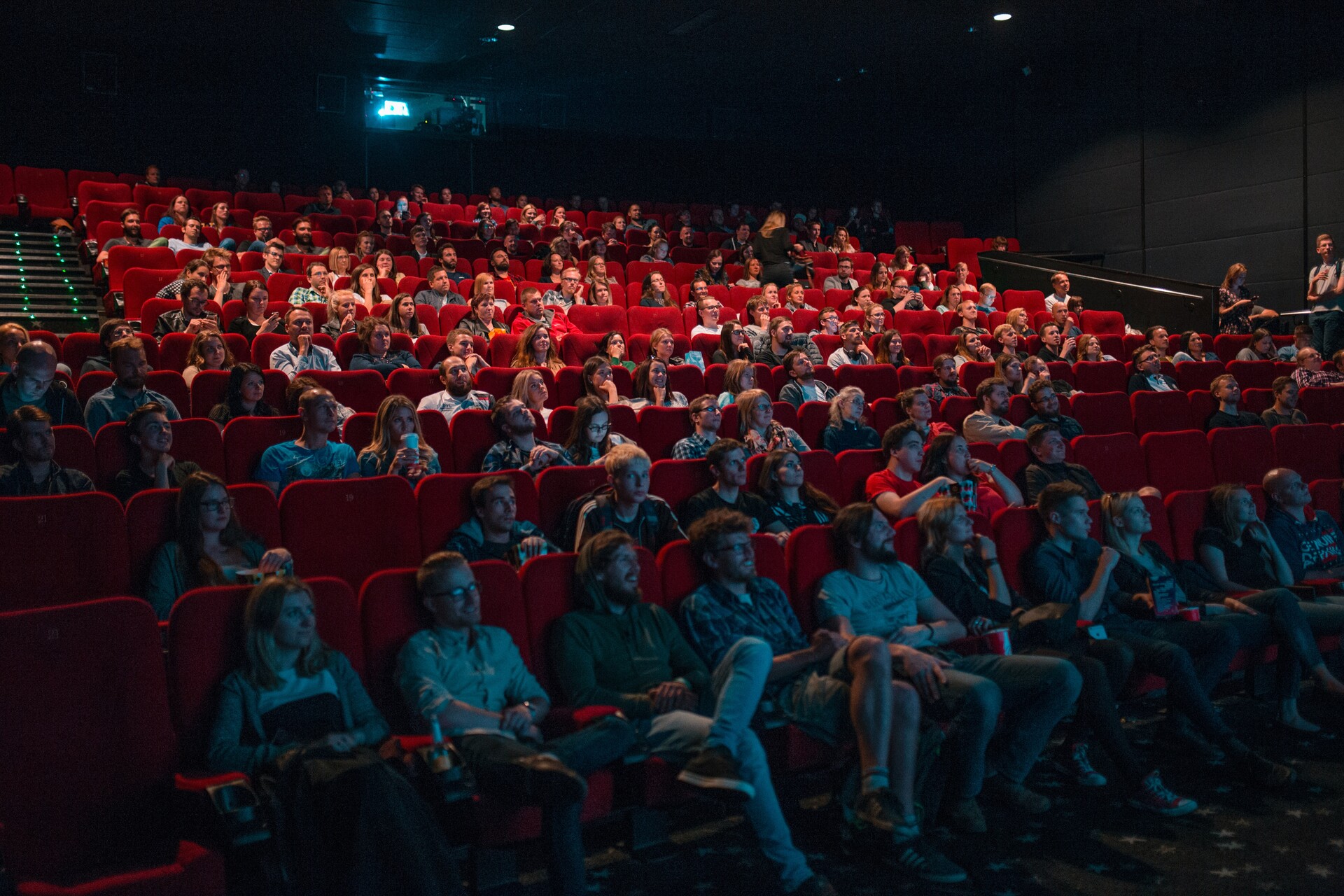
The good thing about going to the movie theatre in Poland is that you can watch all the movies in the original version and with subtitles. Of course, there are dubbed ones, as well. However, if you don’t speak any Polish, it might be hard for you to understand anything. So, go ahead, and go to the movie theatre!
There are over 20 movies theatres in Krakow, most of them near the city centre, for instance, Cinema City, ARS, Kijow, Kino pod Baranami, etc. And if you are a fan of old looking movie theatres with a unique ambience, you should definitely try ARS.
How much does it cost to watch a movie in Krakow? That really depends on the movie theatre you go to. Nevertheless, if you are a student, you should expect to spend between 12 and 20 zloty (3 or 5 euros). Look for student discounts and other offers (2 for 1: Kinder Bueno, Orange). For more information and showtimes, please go to Kina Krakow.
- Continue to Day trips from Krakow - Places to visit and excursions around Krakow
- Return to Public transport in Krakow - Getting around Krakow
Photo gallery
Content available in other languages
Want to have your own Erasmus blog?
If you are experiencing living abroad, you're an avid traveller or want to promote the city where you live... create your own blog and share your adventures!
I want to create my Erasmus blog! →








































Comments (0 comments)